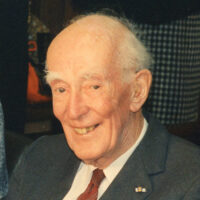
1987 Kyoto Prize Laureates
Earth and Planetary Sciences, Astronomy and Astrophysics
/ Astronomer
1900 - 1992
Professor Emeritus, Leiden University
Origin of Structure in the Universe
1987
11 /12 Thu
10:30 - 17:00
Place:Kyoto International Conference Center
A leading researcher in astronomy and astrophysics, who elucidated the structure and dynamics of the Galaxy through radio observation of the 21cm hydrogen line, derived the position of the galactic center and other basic parameters of galactic rotation, and thus revealed the overall picture of the spiral structure of the Galaxy.
*This field then was Field of Earth Sciences and Astrophysics.
Dr. Jan Hendrik Oort will receive the Kyoto Prize 1987 for Basic Sciences for his long standing contributions to astronomy and astrophysics, particularly for his elucidation of the structure and dynamics of the Galaxy. He found that the Milky Way is a large stellar system of disk shape and rapid rotation, in which the sun is located about two-thirds of its radius away from the center, as we now find in text books. This structure was first derived from his optical observation of the velocities of stars in the late 1920s and was later quantified by the radio observation with the 21cm hydrogen line performed in the 1950s by he and his students. The galactic rotation is characterized by a pair of parameters, called the “Oort constants,” and the motion perpendicular to the galactic disk is dictated by the “Oort mass limit” which is the maximum permissible surface mass density in the solar neighborhood.
One of his important contributions to astronomy was the development of radio astronomy. He initiated the 21cm observation independently of Purcell, and designed radio telescopes including interferometers. Using these radio telescopes, he found high velocity hydrogen clouds falling on the Galaxy, expanding features in the galactic center, and various interesting properties of external galaxies. He has also derived the distance to the galactic center, referring to radio and optical data.
The name of Dr. Oort is also found in the solar system study. In 1950 he showed there is a nest of comets, called the “Oort cloud,” at 100,000 AU from the sun, and comets are supplied from this cloud when disturbed by passing stars. He has also devoted himself to the study of supernovas. One of the most striking discoveries was the polarization of light from the Crab Nebula, a remnant of supernova 1054. This proved the theoretical prediction that the electromagnetic emission is due to the synchrotron radiation by relativistic electrons in magnetic fields.
Through these scientific works and as Professor of Leiden University and Director of Leiden Observatory, he has brought up many astronomers and astrophysicists who are now playing leading roles at various institutions throughout the world. There are many more who feel themselves to be Dr. Oort’s students, though he might not know them. All astronomers and astrophysicists owe greatly to his leadership in scientific research and in the organization of research activity, and are strongly impressed by his enthusiasm. He continues research work even today. His scientific achievements have been recognized with several prizes, the memberships of several academies, honorary degrees and so forth.
Profile is at the time of the award.